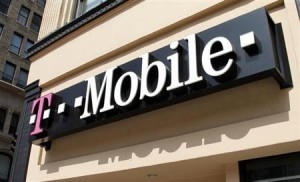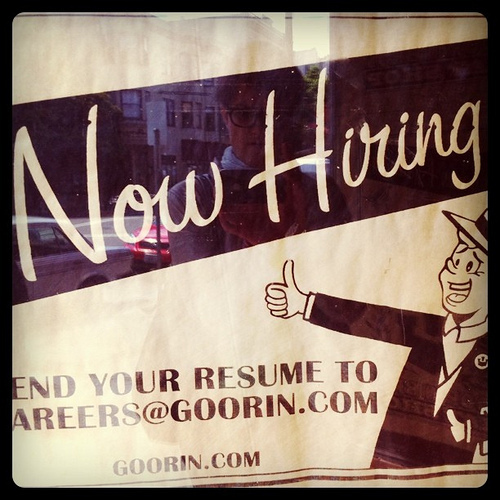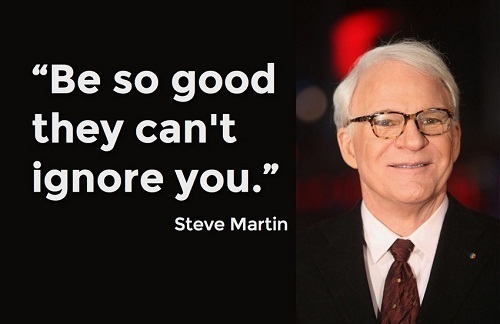Erik Qualman's Blog, page 627
September 25, 2013
Google + Authorship: How to Set Up Your Contributing Writers


Google+ Authorship is a valuable piece of SEO real estate that creates backlinks from author profiles to the content they publish online. It helps establish authors as subject-matter experts (SMEs), and it boosts the value of the content they write on your behalf. If your contributing authors haven’t set up G+ accounts, share this article with them, and tell them to get it done — yesterday. Google launched the ?rel=”author” function in 2011 to push the online community further in the direction of authentic and expert content, which is what consumers want.
Internet marketing experts predict Google will eventually use this Authorship data to create algorithms that rank authors in the same way pages and domains are ranked. Google guru Matt Cutts confirmed in June the company’s search teams are looking at author rank, but have not announced a launch date, Virante, Inc. marketing firm reports.
Heather Ferris, brand manager and contributing journalist at digital marketing agency iAcquire, commented about iAcquire on Google Plus and said its new platform, ClearVoice, will require all contributing writers to have Google+ accounts and authorship.
“We know optimizing your personal profile, as well as establishing Google Authorship, are the quickest ways to the top, rank-wise,” Ferris says. “We want our writers to have the most success, the furthest reach and the highest ranking possible for both their names, as well as the keywords for which they are looking to rank. Every day you don’t have Authorship is a day your competitors are pushing you further into oblivion. My advice? Get Authorship, or find another line of work.”
Benefits of Google+ Authorship
Because Google owns 67 percent of search, comScore reports, (more than the other search platforms combined), it makes sense to build these paths for its algorithms to travel to and from authors’ content.
Google+ Authorship does several important things for your content:
It creates a “rich snippet,” which includes microdata such as the author’s image, byline and a blurb about the content.
Posts linked through Google+ benefit from organic backlinks. Some say Google crawls and indexes these faster, as reported by Y Combinator, but Google denies this.
Author Rank, where Google would rank search results based on how strong a writer’s Google Authorship is, may be coming.
Rich Snippets Boost CTR
You’ve seen rich snippets, even if you didn’t know they had a name. They look like this:
Ask your webmaster if he (or she) has enabled your site for microdata, microformats or RDFa. You don’t need to know what those terms mean, but if he says “No,” ask him to review the rich snippets guidelines in the webmaster tools on Google. Google says rich snippets don’t affect search engine rankings. However, anecdotal evidence suggest they increase click-through rates (CTR):
Russell Jensen of SEOBodyBuilder.com reported a 38 percent increase in CTR.
Cyrus Shepard of Moz.com reported a 38 percent increase in CTR after using his “ugly Google+ pic” (his words, not ours.)
CatalystSearchMarketing.com reported a 150 percent increase in traffic after a couple months.
To test how your rich snippet will look, go to Google Structured Data Testing Tool, and enter the URL of your website. If you did it right, you’ll see your image, your byline and other author data.
Google +1 Versus Authorship
In a lively yet informative exchange on the Moz.com blog, Shepard and Google’s Cutts help us understand how Google treats pages that have been linked through Authorship and +1s, which are comparable to Facebook “Like”s. Cutts said the search engine does not use +1s or Authorship to rank pages and posts. Social media expert Mark Traphagen summed it up best by saying the +1 connection doesn’t in itself boost SEO value. Rather, it’s the organic link that’s created with the link between the post and the author’s profile.
How to Set Up Google+ Authorship
If you’re used to working with Google products, setting up the Authorship will be a breeze. If you’re new to Google (where have you been?), this how-to video, starting at 2:50, explains how to set up a Google+ account and Authorship.
https://www.youtube.com/watch?v=bHoHBEiy4JQ
1. Go to plus.google.com and set up a Google+ Profile. A Gmail address is not required.
2. Go to plus.google.com/authorship, and follow the steps to verify your email address. If the content you publish is on the same domain as your content, once you complete this process, you are set up for G+ Authorship.
3. If your email address and content do not share a domain, go to your Google+ page, and select “Profile” from the set-up tab (Google likes to move this around during its updates. As of press time, it lives above your cover image.)
4. Click the About tab, and find the Links section. Click Edit, and in the Contributor To field, add the root URL of the site to which you contribute content.
5. Google does not automatically link your bylined content to your G+ profile. For every article you write, you must include a link to your G+ profile with ?rel=author at the end of the string. It will look like this: https://plus.google.com/1234567891011...
The Bottom Line…
Your writers’ Google+ authorships benefit both your company and them. They create organic back links that help the SEO value of your content, and they boost the credibility of the writers. It’s a big part of Google’s effort to rid digital channels of garbage content by linking real readers with real writers and creating real connections.
[image error]
September 24, 2013
How T-Mobile Got Back in the Game This Year

As with all business competition, the mobile service provider landscape is rife with companies trying to entice new customers without forfeiting revenues. And like in many areas of business, when one company latches on to a good thing, the competitors are not too far behind. For example, currently the country’s fourth-largest mobile service provider, T-Mobile has recently implemented several changes in an effort to make itself more competitive with the top three including expanding LTE coverage, new discount program and social media tactics.
Go Ahead, Jump
Perhaps the most attention-grabbing change to come out of its arsenal is T-Mobile’s new Jump plan. For $10 per month (plus taxes and fees), it will allow customers to upgrade their phones more frequently and will provide protection against damage, malfunction, loss or theft.
Unlike most competitors, who have adopted a two-year wait period before customers may be eligible to upgrade their phones without penalties, the Jump plan will allow T-Mobile customers to upgrade their cell phones at a T-Mobile store up to twice a year, once they have been on the plan for six months. They will pay the same price for the new phones as do new customers.
Recognizing the benefit of the Jump plan to customers – not to mention their bottom line – since the announcement of the plan, other carriers have also unveiled similar plans intended to keep in lock-step with T-Mobile.
Getting an iPhone “Flagship”
Also in T-Mobile’s corner is the plan to offer the new iPhone from the carrier at the phone’s official launch. This will mark the first time that a new iPhone has been available on all four US carriers at launch.
Apple’s new “flagship” phone to replace the iPhone 5 as well as a lower cost device (5c) will launch in store Sept. 20. Given its far greater focus on prepaid plans than any of its competitors, this lower-priced version of the iPhone may play in T-Mobile’s favor, especially given the many defectors from AT&T to T-Mobile. Having a low-cost iPhone in its inventory could open the floodgates even more.
In ramping up for the iPhone release, T-Mobile says it will offer the iPhone 5s at $199 down, with 24 monthly payments of $22.91 for the 32GB model; and $299 down, with 24 monthly payments of $22.91 for the 64GB model. The iPhone 5c will also be available at $99 down with 24 monthly payments of $22.91 for the 32GB model. These will be offered with an unlimited plan at $50 a month.
With the release of 2013 cell phones including the iPhone 5c and 5s, Samsung Galaxy S4 and Android-based Sony Xperia Z, T-Mobile is poised to enjoy a more even-footing with its bigger rivals.
Flipping the Switch on 4G LTE
Though it was the last of the four major carriers to launch a 4G network, T-Mobile is nevertheless making up solid ground as it now extends 4G network coverage to well over 157 million customers in 116 cities, already covering the top 22 markets. By the end of the year, the company hopes to reach more than 200 million consumers in 200 metropolitan areas. As it sits in fourth place among the top U.S. networks, this news is big for T-Mobile as it sets its sights on Sprint, Verizon, and AT&T.
The extension of its 4G network coverage, its new subscriber plan-lite, and the fact that it continues to pick up those new iPhone customers that AT&T seems to be hemorrhaging at an alarming rate are all hopeful trends in T-Mobile’s race for the top mobile provider spot.
Strong Social Media Presence
For a long time now, T-Mobile has been known to uphold a strong social media presence. In addition to updating and engaging its followers on Twitter and Facebook, T-Mobile also does a fair amount of recruiting for open positions. Also, if you ever have a customer service issue with at T-Mobile, send a Tweet, and most likely you will receive a response within 48 hours. T-Mobile has a strong social media team that works around the clock to provide service and help for customers.
[image error]
September 23, 2013
Using Twitter to Start a Movement

I can still vividly remember the 3rd weekend in January of 2012 when the @BigIdeasEDU Twitter account (now @IdeaBlendEDU) went from 7 followers (our team & someone’s mom) to 700 followers. In the months following that weekend our account continued to grow, and today we have doubled that 700 number to over 1400 followers.
In January of 2012, a small group of colleagues and I had an idea to create a conference that would change the game in Higher Education. We had heart, hustle and Twitter account. Apparently, that’s all you need to start a movement. This story is about the substantial role that Twitter played in the Big Ideas in Higher Ed Conference and the movement it started.
It’s NOT about you (or your conference, or your brand, or..): Our account had one ground rule: the account is not about the conference, it’s about big ideas in higher education. We knew from the beginning that we wanted to be a source of big ideas and innovation in higher ed. People would figure out the account was on behalf of this cool conference, we didn’t need to push that. It was that philosophy that ensured the 700 original followers, excited about the name and profile of the account, actually stuck around. I remember vividly one of the best compliments from one of our followers, “if you are not learning from @bigideasedu you are missing out.” When we saw that a few months in to the planning process, we knew we were accomplishing our goal.
Put resources, time and effort towards maintaining the account: I see lots of events create accounts to push people to buy tickets, tweet random content, and then be a ghost for 2 weeks…only to reappear and push ticket sales again. Maintaining a Twitter account is not something to take lightly, especially if you are trying to start a movement. The team has to be committed to curating content, following hashtags, and engaging in the conversation. The people in charge of social media for your movement should not have any other major responsibilities, this is a job in itself. If you have no choice but to be the founder of your movement and manage the social media, then you will need to focus. Only start with one platform, like Twitter. Fight the urge to start a Twitter, Facebook, Instagram, Pinterest, etc all at once. Stay focused and hustle.
Empower others to join the movement: One of the most epic Twitter moments occurred during the conference. It happened when someone was talking badly about the conference model. We took some big risks in creating an innovative model and very much abandoned the status quo…this didn’t sit well with everyone. It was only a matter of minutes before one of our biggest supporters jumped in to defend the vision. If you are going to start a movement, you cannot let your ego get in the way. You especially cannot let your ego get in the way on Twitter. It’s not your movement, it belongs to everyone that is inspired by the idea. When you see others post content aligning with your ideas, promote their content, engage with them, thank them. They are the reason you have a movement and they are critical to the momentum building.
Use Twitter as an ultimate connector: We knew when we started the account that Twitter would absolutely help to expand our base and connect us to people who believed what we believed. We didn’t know it would connect us with speakers and sell tickets. One of the greatest things Twitter gave us was the connection to @brainzooming founder Mike Brown. We knew we needed a creativity expert but had no clue where to look for one. We tweeted a post about needing someone and used a few hashtags from the creative industry. Later that week we were making arrangements with Mike to come to the conference. He was a phenomenal speaker, huge asset to the event experience, and has been a great partner in our movement. Twitter also helped us sell tickets. As people purchased their ticket they would Tweet about it, and soon enough we’d see an interaction where their friend commented on the tweet saying “if you’re going, I’ll go!”
Use the platforms out there to monitor and pull analytics: Each of our team members had sites they liked using to schedule tweets and monitor analytics. We used BufferApp, HootSuite and TweetDeck in addition to the Twitter app. Many people brush off Twitter and underestimate the powerful qualitative data you can pull from a Twitter feed. Starting a movement with Twitter takes vigilance and a commitment to assessing the account in order to make real-time adjustments to content being shared. Also, after the event, we were lucky enough to have an attendee pull a Hashtracking report on #bigideas12. This data was not only so much fun to read, but incredibly helpful in better understanding the attendee experience. Our big mistake was that we didn’t plan ahead to pull this data, so if it weren’t for an attendee taking the initiative to do it right when they got home we wouldn’t have it. It’s tough to pull that kind of data after the event is over, so plan ahead.
Twitter is a powerful platform. So few of our planning team members had any real clout or credibility in our industry…yet  . We were young, scrappy and smart. Our team wasn’t made up of the typical well-networked large conference planning committee with a big budget. There is no way this kind of national movement could have existed prior to Twitter. This post is dedicated to @IdeaBlendEDU’s amazing followers.
. We were young, scrappy and smart. Our team wasn’t made up of the typical well-networked large conference planning committee with a big budget. There is no way this kind of national movement could have existed prior to Twitter. This post is dedicated to @IdeaBlendEDU’s amazing followers.
[image error]
Big Data: Shifting the Ad Landscape from Mad Men to Digital Scientists

The traditional advertising techniques we once knew have changed dramatically in the digital age. Long gone are the days of print campaigns, television ad buys, radio commercials with a call to action like “Stop by today!” as they stand on their own. Like most other things in the world today, our online social lives have manipulated the advertising process in such a way that campaigns must now be completely immersive or risk being overlooked. A commonly heard call to action is now “Visit us at Facebook.com/x.”
The advertising landscape having long made the transformation into digital, has massively shifted again as advertising giants, Omnicom and Publicis, announced their merger earlier this month making it the world’s largest agency. Both companies hope the merger will allow them to be better equipped in an industry dominated by data analysis and automated ad buying. There are 7 billion people in this world and 6 billion of them have mobile phones. It’s no wonder that data collection one of, if not the, major contributing factors in this merger.
Although it may seem like consumers cannot possibly be more connected than they already are, the fact is that we are becoming increasingly connected each second — infinitely exchanging information continuously with absolutely no end in sight. This obsession with sharing is a watershed for advertising agencies that can harness it and success is measured by reaching the right people and making them buy. Without the proper collection and analysis of this information, anyone not participating is behind the curve; unable to appropriately and acutely target those who are most likely to make a purchase. This information provides advertisers the ability to serve up highly customized and super effective ads; these ads are often also less expensive since there is rarely a message that goes unheard by the targeted audience.
This change in the ad space has shifted focus from the once coveted Madison Avenue ‘Mad Men’ creatives to data scientists and engineers to invent new technologies to perfect digitally driven ads. In the days of traditional advertising, there were far fewer channels through which to reach targeted audiences (consisting primarily of TV, magazines, newspaper, and radio) and reaching them required enormous, overarching campaigns. A costly ad buy on one or more major networks would be considered the most successful; reaching the most people but still knowing only the most basic of information regarding how many viewers are actually watching and their demographics.
The paradigm has shifted now to one where there are an ever increasing number of channels through which to reach people and with it comes a massively growing market to reach. We now need to know consumers’ buying patterns, where they shop, how much they spend, what they need in their lives, where they hang out, what they do for fun, etc. With these non-traditional channels, the emphasis and resources are focused on targeting and reaching the right people — Big Data is the strongest tool available allowing advertisers to do this and reduces the likelihood that their message will fall on deaf ears.
So while messaging still remains of the utmost importance, knowing and understanding the desires of the targeted audience is absolutely invaluable to advertisers, which is what has led Publicis and Omnicom to join forces. The profound change in consumer behavior: The willingness to outright claim what it is that they want, what they like, and what they need from brands paired with their constant desire to connect and be heard is the driving force behind the value in Big Data. These ad giants will now be competing amongst the likes of Google, Facebook, Yahoo, and Twitter — the companies gathering and mining this precious data.
This data-intensive world has introduced competitors that aren’t ad agencies but rather technology powerhouses. The merger won’t make Publicis Ominicom one of them, but it will however grant it the size it will need to accommodate Big Data crunching. Publicis and Omnicom believe that clients will love that the merger has essentially created a one-stop-shop where data mining and ad buys can pinpoint audiences flawlessly.
The Publicis and Omnicom merger is certainly proof of the clout Big Data holds and is the first of many shifts in the industry where we will see data.
[image error]
September 19, 2013
How to Use Social Media to Land Your Next Job
Social media has exploded over the last few years, and more professional companies than ever are turning to websites like Facebook and Twitter to reach out to customers and connect with people. You can take advantage of this new trend in the hunt for your next job. There are many ways you can use social media to aid your search.
Make Yourself a Virtual Resume
Companies are going to want to know about your work history and qualifications before they hire you. Social media can help you show them what you can do before you even have an interview. Add your past jobs, your education, any extra professional training and internships you participated in to your Facebook timeline, or make yourself an “About Me” section on your blogs or other profiles that lists the same information. It lets companies know if you have the qualifications and experience they’re looking for at a glance.
Advertise Yourself to Potential Employers
Image via Flickr by buyalex
Getting a job is about showing an employer that you are the right fit for their company. Social media sites are a great way to start that process before you even apply. It allows you to talk directly to people within the company. You can ask them questions, talk about what you would need to do to work for them, and put yourself on their radar for when jobs become available. Showcase your professionalism, communication skills, and knowledge about relevent topics, as these are what get companies interested in you. Let them see that you would be an asset if hired.
Keep Track of Who’s Hiring
Image via Flickr by Alexandra Leisse
A lot of businesses use social media to let people know what’s going on with the company. This includes hiring events, job fairs, and open positions. If you have specific companies you want to work for, liking or following them on social media websites can help you keep track. If you don’t have a specific company in mind, many job search sites also have ways to connect through social media. These pages are invaluable tools, so if you start having trouble with the website, you should try looking for a new internet service provider with InternetServiceProviders.com.
Keep Your References Handy
Any site where you’re able to add friends or followers is a great way to keep in touch, and not just with friends and family. Use them to keep up with anyone you plan to use as a reference when you go in search of new jobs. Past employers, coworkers, and instructors should all be added so you can get updated contact information and ask to put them on your résumé or applications. If you aren’t comfortable having them see your personal information, put them in a separate list on Facebook and limit what they can see on your profile.
Social media has grown from something just used for keeping up with friends and relatives into something people actively use to showcase their work and get in touch with employers. Properly used, these websites are fantastic tools that can help you advance your career and land your dream job.
[image error]
The Oregon Ducks Use Instagram to Create the Ultimate Fan Experience

Have you ever watched a college football game and wondered what it might be like behind the scenes, in the locker room, or inside the huddle as the players are jumping up and down and shouting to rile each other up? The University of Oregon knows just how you feel, and thats why they are the masterminds behind one of the greatest social media campaigns in college sports. In this post I am outlining the formula for success that they have created, so that you can apply the model to your business or brand.
 Here we are, just three weeks into the college football season and we all have our favorite teams. With the growing popularity of Instagram and Vine, it was only a matter of time before a team stepped up to the plate and gave us all an inside look. Kudos to University of Oregon for doing just that!
Here we are, just three weeks into the college football season and we all have our favorite teams. With the growing popularity of Instagram and Vine, it was only a matter of time before a team stepped up to the plate and gave us all an inside look. Kudos to University of Oregon for doing just that!
Last year, the Oregon Ducks made their first critical decision in their journey to success when they launched a social media command center that keeps a pulse on everything related to the Oregon Ducks athletics. They are particularly paying special attention on game-days throughout the football season to engage with their fans. This was an important investment the Ducks made in amplifying their social media presence. Even if you are unable to invest in a command center, the lesson here is to be intentional and devote time and resources into a strategy for monitoring and engaging.
In addition to engaging through their command center, they are executing their Oregon Ducks Instagram account to a T.
What are they doing so well?
They are posting no more than 3 times a week which may not sound like a lot, but their content is so good that when it pops up on your feed you’re excited to see it. They have struck the important balance between quantity and quality.
The Ducks are known for having a good partnership with Nike, and have gained the reputation of always having apparel that is cutting-edge. With their Instagram account, they were able to amplify this part of their reputation by letting their audience get a super close look .
Next, they are posting intense Instagram videos of players getting pumped up before a game and practicing on the field . The videos give fans an authentic look into this (once) private experience shared by the players, and they don’t over-complicate by trying to make it too fancy. The lesson here is that simplicity is the ultimate sophistication. It’s worth a look for yourself, check out one of their videos here .
Lastly, the number one thing they are doing is putting the camera (a.k.a. the fans) where the average University of Oregon Duck has never been before. They have clearly done their research, and spent time brainstorming what the ultimate fan experience could look like. They took that list of ideas and the rest is history.
The big lesson to learn from all of this, is to think about the story you are not sharing on social media and how can you start to tell that story. We love to hear the ‘inside story’, it’s how TLC and a variety of other cable networks are able to stay afloat. We want to know the story behind the duck call fabrication business (Duck Dynasty), running a bakery (Cake Boss), and fixing failing bars (Bar Rescue) among many other stories. No matter what business or industry, you have a ‘behind the scenes story’ to share with your fans.
I’m sure this will surprise you, but I am actually not a Ducks fan. I never went there, nor do I work for their social media staff. I just know a good campaign when I see one, and have a passion for the creativity we can find in a well crafted digital voice. My two favorite college football teams are Rutgers and Notre Dame. What are your favorite teams?
Instagram: OregonGridIron
Kevin O’Connell
Don’t be shy. Connect: Twitter Facebook Instagram LinkedIn
[image error]
September 17, 2013
4 Simple Things Business Owners Forget When Pitching to Clients

To sell, pitch, market, promote, and basically get the word out on your business is probably one of the most important things a business owner has to get around to do.
It’s not as easy as writing it down on your “to do” list though. Modern day entrepreneurs put in thousands of hours, not to mention blood, sweat, and tears, before a single pitch goes out (if you can call it a pitch, that is, since it’s much more than that).
The hours also include time for product creation, charting out processes for a service, hiring people, setting up infrastructure, and working on a hundred different things before entrepreneurs get ready to send out a proposal.
Surprisingly, even making the sales pitch is an incomplete endeavor without the following simple, but necessary steps. Here’s a look at what most business owners miss out on:
Combining Incredible Products/Services with a Website that Works
It’s one thing to grab and idea and walk the ramp with it; it’s entirely something else to make the idea sweat it out to make it work for your business. Idea is nothing without execution. Any action towards this idea without due importance to value is abortive.
To get it right, you can ask yourself this: I got this idea, and it’s awesome because it solves this overarching problem most people seem to have. The question is: how do I create, position, and market this product so that I can create an irresistible offer? What can I do to make my products or services truly indispensible?
Sweating on the work to build products and services to answer that question takes a long time. You can either work on it first and launch later or launch now and work on it as you go along using customer feedback. Whatever you do, you’ll need great products or services.
The key, however, is to make sure that there can be no possible way a competitor can pull the rug from under your feet.
Executing a Marketing Plan that Actually Works for You
Landing on the right channels for marketing your business is possible only if you invest and experiment. While some routes are mandatory, most others are optional. Business owners tend to take the popular route: what seems to be working for most businesses could work for your business – this is a simple oversight.
Dropbox, for instance, barely invested in advertising at all. Yet, it’s now worth $4 billion. By 2011, Dropbox made about $240 million. More than a billion files are saved to Dropbox every 48 hours. It has over 50 million users and over 100 employees.
What did Dropbox do to achieve this?
To start with, it built a sign-up page with an easy sign-up process that was designed to collect sign-ups (that’s 3 sign-ups in a sentence). Secondly, it made an irresistible offer with a “free” start. Thirdly, it had a referral program (with incentives) from day one of the launch. Finally, it leveraged social media by rewarding followers with incentives (such as a 125 MB increase in storage space).
Dropbox isn’t the only company. There are many others—here’s how Zara, a fashion retailer, grew without investing in ads. You may also want to learn how Spanx grew into a billion dollar business with just word-of-mouth, the “Oprah Effect,” and better packaging.
Find out what kind of marketing works for you. Keeping up with the Joneses in advertising can be expensive.
Building a Brand
Large businesses grow bigger because of their brand and they’ll continue to do so. Small businesses, however, make a mistake to think that they are too small for worrying about “branding.”
Here’s one definition: a brand is a perception formed in customers’ minds about the reliability, consistency of maintaining quality, and the overall feel about transactions with a business. It’s clear from this that businesses of all sizes need branding.
If you’re a small business owner and still unconvinced, maybe Anita Campbell of Smallbiztrends.com can convince you.
Right from an individual freelancer to a mega-corporation, branding has little to do with logos and corporate identity (contrary to public perception), although these are good for business. Brand has more to do with the promises you keep and how much your customer loves you.
You need to start with stability, strength, and consistency when looking to create a brand. Having a simple-sounding and basic thing such as a fully functional, good-looking website that can hold its ground is a lot more difficult than you can imagine. Use a service like WhoIsHostingThis to make sure you select a hosting provider that ensures zero downtime for your site.
Then you move on to the “perception,” for which you always have work to do—constantly define and redefine what your brand stands for. What is it about your brand that a makes a customer sit up and notice? Associate colors, characteristics, people, and designs with your brand. Once you pick and choose what sticks, keep it forever.
Hoarding up Social Proof
In the world of the web, which is increasingly same as the world itself, you can’t afford not to be social. Get this:
Over 70% of Americans say they look at product reviews before making a purchase, according to research by Power Reviews.
For the consumer packaged goods industry, visitors who read reviews have a 6% higher average order value than those who don’t, reveals research by Bazaarvoice.
What sort of conversation do you have with your customers on Facebook? Do you tweet anything more than your blog posts on Twitter? Do enough professionals follow your company page on LinkedIn? What’s on your blog and what criteria do you have for publishing on it?
The truth is, most companies can’t bring their owners to read their blog, let alone clients.
If you have a namesake presence on social media and your only followers are ghosts, if you don’t take part in conversations and fail to rake up online interest in your products, don’t be surprised if no one ever mentions you anywhere.
And how does that go for first impressions?
Social media and content marketing is a long-term investment. It’s more to do with caring, sharing, and solving others’ problems. It’s the most modern way of shouldering responsibility to community. As you do this continuously, every single day, you build loyal followers and fans.
It’s a nice feeling to have customers or clients follow you when you have a busy social media presence.
Rome, or Kabul for that matter, was not built in a day. All of these are long-term plays and it will necessitate incessant marching on your part to get there.
While I still believe that you should go out there and make your pitches (sales came before marketing), it’s time to work hard to make inbound marketing work for you. Get customers knocking on your door!
[image error]
September 16, 2013
We Should be Teaching Students How to Blog

Social media is the ultimate equalizer. It flattens hierarchy and empowers those with big ideas and hustle to get their message out to the masses. Young people today have an incredible opportunity that is the envy of many big thinkers that came before them. They have a medium in which to share their ideas and passions with the world quicker, cheaper and further reaching than ever before. They can blog.
We need to teach young people how to blog.
Plain and simple, the single most empowering thing one can do for a student is help them find their voice. Today, we can’t stop there, we must also help them find and amplify their digital voice. When I was working at Rutgers, I taught our student leaders how to blog. Here are a few lessons I learned from this experience.
Lesson #1: First critique, then write
Just because students grew up as ‘digital natives’ doesn’t mean they know how to navigate social media or blogging like an expert. It is important to have students identify what makes a good blog post before they write their own. Have students start by being the critic before they are a writer. Have them find a blog post that resonates with them, and ask them critique the content, design, voice etc.
Lesson #2: Give them autonomy
Give them some autonomy when it comes to what they will write about. At Rutgers we gave our students an “experiential checklist” (comment below if your interested in seeing the checklist, and I will send it to you) with 25 items from which to choose. Over the course of the semester they picked 3 experiences to do and then blog about. A few sample experiences are:
Interview a parent of an incoming college student and write about the experiences, fears and feelings associated with sending a child to college.
Attend a meeting of a club as a non-member, and write a critique of how they run their meetings.
Watch 3 different movies set on a college campus and write about the way the media depicts the college experience.
Lesson #3: Make it real
Use an actual blog. So many universities say they use blogging in classes, but really its just the LMS “blog function”. We used Blogger one semester and WordPress the others. It doesn’t really matter what you use, as long as it is real. When it’s an actual blog it feels real and students are more compelled to make it a good post. Posts are shared on Facebook and Twitter, and students learn to take pride in their work. Also they are starting to build their digital footprint, as the content will be searchable if it is on a real blogging platform.
Young people are our future leaders, and they will need to have a strong digital reputation among many other skills and traits to thrive as a leader. Infusing blogging into the curriculum and co-curriculum will empower our students to be digital leaders, and teach them an important skill they can use in just about any industry they enter upon graduation. Are you working in education? How have you taught students to build a strong digital reputation? I’d love to hear about it.
[image error]
Top 10 Expensive iPhone Applications

App Store’s news update, “Apple’s App Store Marks Historic 50 Billionth Download” says it all for the popularity of iPhone apps. While you must have regularly been reading about top free iPhone apps and top paid iPhone apps, let me dare to present to you a list of the top 10 expensive iPhone applications.
Now, as I stress on the word ‘dare’ so I believe many eye-brows as raised by now as to ‘why purchase ‘Expensive Apps’. Well, there must be reasons why they are expensive. They are not ‘run-of-the-mill’ app which every other iPhone developer could even attempt to build. Check out these expensive yet classy and innovative iPhone applications from App Store:
TOP 10 EXPENSIVE iPHONE APPS
iParkinsons (Medical) – $999.99
 Developed by Casa Futura Technologies, iParkinsons app is built to treat the speech disorders associated with Parkinson’s disease, including hypokinetic dysarthria. It works by changing the way you hear your voice in earphones like
Developed by Casa Futura Technologies, iParkinsons app is built to treat the speech disorders associated with Parkinson’s disease, including hypokinetic dysarthria. It works by changing the way you hear your voice in earphones likeMultitalker babble noise treats hypophonia or low vocal volume
Delayed auditory feedback (DAF) treats festinating speech or “run together” words.
Pitch-shifting frequency-altered auditory feedback (FAF) modifies the pitch of the user’s voice in his or her earphones.
In short, the unique iParkinsons app delivers a visual display of your vocal volume. If you want to project that what you are saying is meant to be loud, just try to get your voice into the red zone. And the best part about this app is that it is like a tool kit that can be customized to the requirements and extent of problems for each user.
CyberTuner (Music) – $999.99
 Developed by Reyburn Piano Service, Inc, CyberTuner app for iPhone is a professional piano technicians’ tuning tool. The app build for iOS took 3 long years for development and a year of intensive testing by master piano technicians around the world. So, you know now, what makes it expensive and the one to be treasured.What makes CyberTuner app for iOS a superior tuning software is it user friendliness, functional clarity and intuitive and thoughtful design. The best thing is its flexibility to tune the way you want with unbelievable accuracy. Moreover, Cybertuner app users can seek support by the creator, which is through personal email (for international users) or toll-free phone (in the US & Canada) for registered users.
Developed by Reyburn Piano Service, Inc, CyberTuner app for iPhone is a professional piano technicians’ tuning tool. The app build for iOS took 3 long years for development and a year of intensive testing by master piano technicians around the world. So, you know now, what makes it expensive and the one to be treasured.What makes CyberTuner app for iOS a superior tuning software is it user friendliness, functional clarity and intuitive and thoughtful design. The best thing is its flexibility to tune the way you want with unbelievable accuracy. Moreover, Cybertuner app users can seek support by the creator, which is through personal email (for international users) or toll-free phone (in the US & Canada) for registered users.
DDS GP Yes! (Medical) – $499.99
 Developed by Kick Your Apps, Inc., DDS GP is one of the best apps available for dentists worldwide. Designed exclusively for dental professionals, this app helps improve your presentation of dental conditions and treatment to patients. One of the main reasons leading to its greater case acceptance is it’s easy to understand treatment plans for patients. DDS GP Yes! app with over 200 unique demonstrations, teaches the best way to explain conditions and treatment plans; besides methods to help influence patients to make good health care decisions.
Developed by Kick Your Apps, Inc., DDS GP is one of the best apps available for dentists worldwide. Designed exclusively for dental professionals, this app helps improve your presentation of dental conditions and treatment to patients. One of the main reasons leading to its greater case acceptance is it’s easy to understand treatment plans for patients. DDS GP Yes! app with over 200 unique demonstrations, teaches the best way to explain conditions and treatment plans; besides methods to help influence patients to make good health care decisions.
Mobile Cam Viewer Enterprise Basic Version (Utilities) – $349.99
 Developed by mobiDEOS, Inc, this app helps you keep a watch and PTZ control your live security & surveillance cameras, DVR, NVR, Video Server and webcams anytime/anywhere on your iPhone. The USP of this app is remote monitoring, which you can accomplish with just the touch of a button.The priceless features of this MobileCamViewer app that justifies its expensive tag are its reliability, secure and private viewing of the access information as it is encrypted Triple DES 112 bit Sun JCE (making it impossible even for the developers to view the stream). Moreover, it allows multiple users can view the same camera concurrently.
Developed by mobiDEOS, Inc, this app helps you keep a watch and PTZ control your live security & surveillance cameras, DVR, NVR, Video Server and webcams anytime/anywhere on your iPhone. The USP of this app is remote monitoring, which you can accomplish with just the touch of a button.The priceless features of this MobileCamViewer app that justifies its expensive tag are its reliability, secure and private viewing of the access information as it is encrypted Triple DES 112 bit Sun JCE (making it impossible even for the developers to view the stream). Moreover, it allows multiple users can view the same camera concurrently.
Buddy Repperton’s Gold App (Games) - $299.99
 Developed by Rand Alexander, Buddy Repperton’s Gold App consists of BEST plays collection in all sports from this year’s Super Bowl on February 3, 2013 through next year’s Super Bowl [one full year]. Marked as one of the ultimate sports app for Buddy’s Premium Selections, this app will comprise of the very best of Buddy’s premium selections in pro and college football, pro and college basketball, MLB, WNBA, Arena football, CFL, European basketball leagues (including FIBA) – throughout 2013 and through the Super Bowl played in February 2014. You can see the selections posted daily on the High Scores page of the app under scores of 100.
Developed by Rand Alexander, Buddy Repperton’s Gold App consists of BEST plays collection in all sports from this year’s Super Bowl on February 3, 2013 through next year’s Super Bowl [one full year]. Marked as one of the ultimate sports app for Buddy’s Premium Selections, this app will comprise of the very best of Buddy’s premium selections in pro and college football, pro and college basketball, MLB, WNBA, Arena football, CFL, European basketball leagues (including FIBA) – throughout 2013 and through the Super Bowl played in February 2014. You can see the selections posted daily on the High Scores page of the app under scores of 100.
TuneLab Piano Tuner (Music) - $299.99
 Developed by Real-Time Specialties, this application is a professional tool that helps you produce a custom piano tuning for any piano. The TuneLab Piano Tuner app, which can be calibrated to an accuracy of 0.02 cents provides an over-pull mode for pitch-raises. While it has the ability to store hundreds of tuning files for individual pianos, it switches notes automatically as you start playing the next note.Moreover, the app offers a versatile frequency spectrum display with a Fourier Transform; and a strobe-like phase display for fine-tuning. There are 2 displays visible at TuneLab Piano Tuner – the phase display and the spectrum display. You need to have both the displays visible so as to give you a more complete picture of the tuning than any single spinner-type or needle-type display.
Developed by Real-Time Specialties, this application is a professional tool that helps you produce a custom piano tuning for any piano. The TuneLab Piano Tuner app, which can be calibrated to an accuracy of 0.02 cents provides an over-pull mode for pitch-raises. While it has the ability to store hundreds of tuning files for individual pianos, it switches notes automatically as you start playing the next note.Moreover, the app offers a versatile frequency spectrum display with a Fourier Transform; and a strobe-like phase display for fine-tuning. There are 2 displays visible at TuneLab Piano Tuner – the phase display and the spectrum display. You need to have both the displays visible so as to give you a more complete picture of the tuning than any single spinner-type or needle-type display.
MBA Platinum Edition – MBA Learning Solutions (Business) – $299.99
 Developed by Intersog, this app has been awarded the ‘Best Education App’ in 2011. This interactive tool is loaded with interesting features that promises to make education fun, while helping you learn the fundamental skills necessary to succeed in the world of business today.The MBA Platinum Edition courses range from introductory surveys of general professional concepts, to more advanced courses focusing on applied concepts specific to business, management, or finance. Here each of the 34 courses includes complete course texts, interactive flashcards for subject review, comprehensive chapter-level tests, explanations of correct and incorrect answers, glossary, newly added fonts and most importantly it works without Internet.
Developed by Intersog, this app has been awarded the ‘Best Education App’ in 2011. This interactive tool is loaded with interesting features that promises to make education fun, while helping you learn the fundamental skills necessary to succeed in the world of business today.The MBA Platinum Edition courses range from introductory surveys of general professional concepts, to more advanced courses focusing on applied concepts specific to business, management, or finance. Here each of the 34 courses includes complete course texts, interactive flashcards for subject review, comprehensive chapter-level tests, explanations of correct and incorrect answers, glossary, newly added fonts and most importantly it works without Internet.
Proloquo2Go (Education) – $219.99
 Developed by AssistiveWare, the Proloquo2Go® app provides a “voice” to over 50,000 individuals around the world, who are incapable to speak or have speech disorders. In short, you can say this app enables people to talk (express) using symbols or typed text in a natural-sounding voice that suits their age and character. This award-winning Augmentative and Alternative Communication (AAC) solution from is a great buy, as good as good as a dedicated AAC device yet affordable.Besides being loaded with Intuitive, powerful and easy to use editing interface for customizing pages, folders and buttons, the best thing about Proloquo2Go® is that it does not require an active internet connection.
Developed by AssistiveWare, the Proloquo2Go® app provides a “voice” to over 50,000 individuals around the world, who are incapable to speak or have speech disorders. In short, you can say this app enables people to talk (express) using symbols or typed text in a natural-sounding voice that suits their age and character. This award-winning Augmentative and Alternative Communication (AAC) solution from is a great buy, as good as good as a dedicated AAC device yet affordable.Besides being loaded with Intuitive, powerful and easy to use editing interface for customizing pages, folders and buttons, the best thing about Proloquo2Go® is that it does not require an active internet connection.
Water Globe (Entertainment) – $219.99
 Developed by Ubiquitous Muffin, the Water Globe app is a set of interactive screen toys. While the globe runs a fluid dynamics simulation, besides using gravity and shaking to produce snow motion, you just need to use your fingers to churn up the white snowflakes. You can also set the globe to snow storm mode and leave it running as a “screen saver”.
Developed by Ubiquitous Muffin, the Water Globe app is a set of interactive screen toys. While the globe runs a fluid dynamics simulation, besides using gravity and shaking to produce snow motion, you just need to use your fingers to churn up the white snowflakes. You can also set the globe to snow storm mode and leave it running as a “screen saver”.
XA1 (Music) – $179.99
 Developed by Mark’s, XA1 is a real-time spectrum analyser for the iPhone and iPod Touch. Built to deliver realtime feedback of the audio spectrum, XA1 helps you with a visible reference for your sound, when mixing or doing other audio related work. The app loaded with 1/3, 1/6, 1/12 octave filters works with the build-in microphone on the iPhone.
Developed by Mark’s, XA1 is a real-time spectrum analyser for the iPhone and iPod Touch. Built to deliver realtime feedback of the audio spectrum, XA1 helps you with a visible reference for your sound, when mixing or doing other audio related work. The app loaded with 1/3, 1/6, 1/12 octave filters works with the build-in microphone on the iPhone.Have you downloaded any of these apps? Share your experiences.
[image error]
September 13, 2013
Social media marketing strategy: Merits and demerits that change time to time

The popularity of social media sites like Facebook, Twitter, Google Plus, LinkedIn, etc. has simply gone up since the past few years. If you check the number of users over these sites, Facebook alone has around 1 billion users, whereas other sites like Twitter and Google Plus too are gearing up in terms of number of people using it. Owing to the massive amount of people present over these sites, the online marketers have started targeting these platforms to promote and market their businesses. Though the social media has loads of people, which can render you the targeted crowd but using these platforms can have their own pro and cons. The fact is these merits and demerits can change from one point of time to the other. This is the way these platforms have evolved and the ways these sites are being used by the online marketers to market their brand or businesses. Since the social media world is very much dynamic in nature hence it will bound to change. Anything dynamic in nature would obviously change and so would be the things around it including the merits and demerits you enjoy with social media marketing strategies.
Social media marketing strategy benefitting the smaller brands more than the larger ones
One of the basic benefits marketers enjoyed was the ease and simplicity to reach out to the target audience. When social media was making its mark in the earlier years, only bigger brands were seen benefiting the most. However, as time passed, you can see a paradigm shift in the terms of benefitting from the social media strategies. Now you can see the smaller and medium size businesses leveraging these opportunities the most rather than the bigger brands in the market. In fact, over the past five years, you can see smaller business marketers changing their attitudes a lot towards social media, which seems to be moving from dismissive passivity to the cautious curiosity. Since past two years, you can see smaller businesses making their mark in the market with competent social media marketing strategies more than the bigger brands. That way, the merits of social media marketing seems to be changing a lot.
The constant technological growth changes the pros and cons of social media marketing
If you look at the possible benefits or merits of social media marketing in the current era and the previous ones, you can certainly find a couple of differences. Earlier these platforms were simply the places to trigger communication between marketer and consumers but now things are changing a lot. Now, this particular benefit has gone beyond getting the opportunity to find people to engage using different social media strategies for different brands or businesses. You can see a couple of development in terms of social media engagement. Now the customers or targeted people are engaged using different social media strategies via a number of tools and apps present over the social media sites. For instance, if you look at Instagram, it has simply evolved a lot and has now revolutionized the idea of customer or target audience engagement with the different marketers that are active over social media sites. In a sense, with all the changes or growth of technology surrounding social media, everything surrounding these platforms including the social media marketing pro and con is seen changing a lot. That’s the law of nature, which would be also seen over the social media platforms as well.
The social element of social media and social media marketing
Let’s not forget that social media came into existence with the idea of social aspects of human being. Man is social in nature, and hence is called as social animal. Despite being busy in the high demanding marketplace, it is imperative for them to quench the social thirst found in him. Hence when social media was introduced, it was simply embraced quickly by such people. Hence now you can see every Tom, Dick and Harry having his account over different social media sites. With this massive amount of popularity of social web among the masses then came the terms like social media marketing, which is a method to use these platforms to reach out to different target audience for bigger and smaller brands. Leveraging from these sites for your business interests may burst someday or the other if you tend to poke your nose more for the business rather than social reason. What appeared as big merit over social media would soon be appearing like a con for businesses. With passage of time, technological growth, market pressure, let’s not forget the social angle of social media even if you are carrying out your social media marketing activities. However, this may not be possible to every social media marketer active over this platform; hence for such bandwagon of marketers, the merits and demerits of social media would keep on changing with passage of time.
Final word
Everything on earth is bound to change, which is dynamic. If you look at the social media, it is among the most dynamic platform over the web; hence the changes inside it would be inevitable. This change would certainly be seen over the social media marketing merits and demerits as well.
About Author: This Post is written by Kelly. She is a writer/blogger. She writes articles on Technology, social media, WordPress, Gamification, website development and online development etc. These days she contributes on luxury
[image error]













